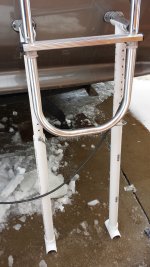danemayer
Well-known member
On our extended ski trips, I have to frequently get up on the roof, sometimes twice a day if there's heavy snow. I've been experimenting a bit with ways to reduce flex that loosens the standoffs.
The flex originates at the top of the ladder. The first 90 degree bend as it comes out of the roof mount is the part that flexes. The horizontal standoffs can't do much to reduce the flex.
I thought perhaps reinforcing that first 90 degree bend might get rid of the flex. I found some conduit guides that fit but it was obvious that the flex problem was moved to the roof mount. Not wanting to damage the roof or roof mount, I gave up on that idea.
I've been using 2x4s with notches to support the ladder at the lower standoffs. The first problem I encountered is that depending on slope of the site, the height of the supporting 2x4 might have to vary quite a bit. I tried out 2x4s with a series of notches, which provided the necessary support, and allowed for different heights. Unfortunately, having cut multiple notches weakened the wood and it wasn't long before a notch broke off.
HOWEVER, the basic concept of providing support from underneath did stabilize the ladder and eliminate the flex.
Before our latest trip, I decided to try out a PVC solution, pictured below. The top pipe is 1-1/2" which slides into a 2" pipe. A tee fitting is attached to the top of the 1-1/2" pipe and another tee fitting is glued to the bottom of the 2" pipe. The horizontal portion of the tee fittings have been cut lengthwise on a radial arm saw as shown. That allows the top tee to embrace the ladder standoff and the bottom tee to provide a foot to grip various surfaces.
Drilling holes in the 1-1/2" pipe allows the top pipe to be pinned at the necessary height. Drilling at 1/2" spacing and then rotating 90 degrees and drilling another set of holes at 1/2" spacing allows me to set the height to the nearest 1/4" and the locking pin holds the pipes together at the selected height.
All the parts came from Home Depot.




I realize that everyone would prefer to not have to do modifications to get a reliable ladder, but until such a time as a more stable ladder is available, and there's a retrofit kit, maybe you'll find this helpful.
For the cracking endcap problem, a small hose clamp mounted over a 1/2" strip of gasket material underneath each endcap keeps the rungs from moving and stops the endcaps from breaking. It's not beautiful, but I've had no problems for the past 3 years.
The flex originates at the top of the ladder. The first 90 degree bend as it comes out of the roof mount is the part that flexes. The horizontal standoffs can't do much to reduce the flex.
I thought perhaps reinforcing that first 90 degree bend might get rid of the flex. I found some conduit guides that fit but it was obvious that the flex problem was moved to the roof mount. Not wanting to damage the roof or roof mount, I gave up on that idea.
I've been using 2x4s with notches to support the ladder at the lower standoffs. The first problem I encountered is that depending on slope of the site, the height of the supporting 2x4 might have to vary quite a bit. I tried out 2x4s with a series of notches, which provided the necessary support, and allowed for different heights. Unfortunately, having cut multiple notches weakened the wood and it wasn't long before a notch broke off.
HOWEVER, the basic concept of providing support from underneath did stabilize the ladder and eliminate the flex.
Before our latest trip, I decided to try out a PVC solution, pictured below. The top pipe is 1-1/2" which slides into a 2" pipe. A tee fitting is attached to the top of the 1-1/2" pipe and another tee fitting is glued to the bottom of the 2" pipe. The horizontal portion of the tee fittings have been cut lengthwise on a radial arm saw as shown. That allows the top tee to embrace the ladder standoff and the bottom tee to provide a foot to grip various surfaces.
Drilling holes in the 1-1/2" pipe allows the top pipe to be pinned at the necessary height. Drilling at 1/2" spacing and then rotating 90 degrees and drilling another set of holes at 1/2" spacing allows me to set the height to the nearest 1/4" and the locking pin holds the pipes together at the selected height.
All the parts came from Home Depot.




I realize that everyone would prefer to not have to do modifications to get a reliable ladder, but until such a time as a more stable ladder is available, and there's a retrofit kit, maybe you'll find this helpful.
For the cracking endcap problem, a small hose clamp mounted over a 1/2" strip of gasket material underneath each endcap keeps the rungs from moving and stops the endcaps from breaking. It's not beautiful, but I've had no problems for the past 3 years.

